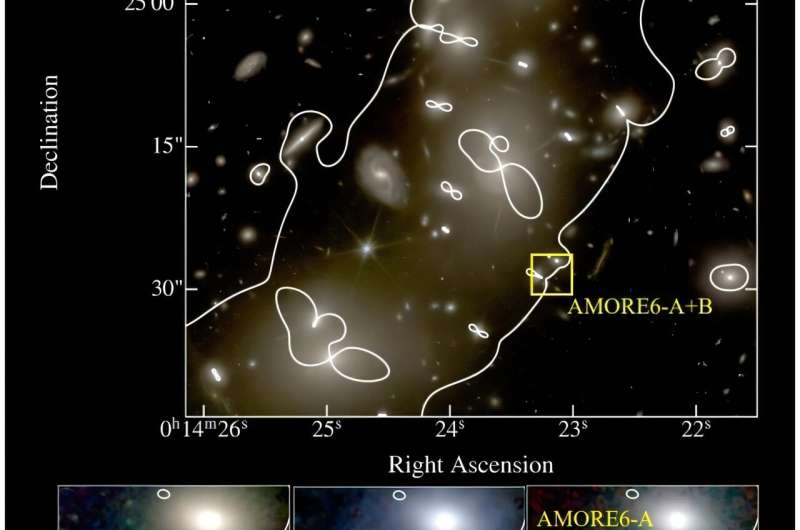
A variety of galaxies are seen in this JWST image. Astronomers are hunting for ancient pristine galaxies that confirm our understanding of the universe and the Big Bang. Credit: NASA, ESA, CSA, Kristen McQuinn (STScI)
Our understanding of the universe begins with the Big Bang, a moment in time where the universe began expanding into what we see around us now. Big Bang nucleosynthesis describes how only the lightest elements were created originally: hydrogen, helium, and a tiny bit of lithium. For elements heavier than those, which astrophysicists call metals, a generation of stars had to live and die.
This first population of stars is called Population 3 stars, and they forged the universe’s first metals, the elements heavier than hydrogen and helium. Pop 3 stars themselves had no metals, or extremely low metallicity, and they forged them through stellar nucleosynthesis. Stars don’t form in isolation, they form in galaxies, so there should’ve been Pop 3 galaxies as well, and their stellar population should have had no metals.
Our understanding of the universe is incomplete, to put it mildly, and there are some missing pieces of evidence that scientists would love to find. These missing pieces would confirm that we’re on the right track to understanding nature. One of the missing pieces is the elusive Population 3 galaxies. There should be early galaxies at high redshifts that have zero metallicity, and finding them would be additional evidence that supports our understanding of the universe.
The James Webb Space Telescope has surprised us all by finding large, fully-formed galaxies much earlier in the universe than we thought. It’s shaken up scientists’ ideas of how the universe has evolved. According to our pre-JWST understanding, galaxies this large and mature shouldn’t have existed so early in the universe’s history, and their discovery has sent a strong ripple of curiosity through the science community.
But even though the JWST has found these large galaxies at such an early age, it hasn’t found a zero-metallicity galaxy. The powerful JWST telescope has detected galaxies that formed only a few hundred million years after the Big Bang, but so far has not detected any of these zero-metallicity galaxies with confidence.
When it comes to observing the cosmos, oxygen can play a key role. The Big Bang cosmological model says that there should be early galaxies with nothing heavier than hydrogen and helium, and that includes oxygen. The OIII emission line in spectroscopy can show astronomers a number of things. It indicates star-forming activity, and is especially useful at measuring that activity at high-redshifts. It’s useful for observing high redshifts from the ground, and even more useful when measured by space telescopes like the JWST.
In very early galaxies, strong OIII emissions indicate low metallicity. When astronomers find a galaxy with low OIII emissions, it also suggests that they formed in conditions very different from now. Up until now, they haven’t spotted any convincing examples.
But that might have changed. New research submitted to Nature presents the discovery of a galaxy that may be pristine. The research is titled “Pristine Massive Star Formation Caught at the Break of Cosmic Dawn,” and the lead author is Takahiro Morishita, who is a staff scientist at the Infrared Processing and Analysis Center (IPAC) at the California Institute of Technology. The research is available on the arXiv preprint server.

This figure shows a mosaic image of the Abell 2744 field. The observed position of the AMORE6-A+B system is shown by the yellow square. Credit: Morishita et al, arXiv (2025). DOI: 10.48550/arxiv.2507.10521
“The existence of galaxies with no elements such as oxygen—formed by stars after Big Bang nucleosynthesis—is a key prediction of the cosmological model,” the researchers write. “However, no pristine “zero-metallicity” Population III galaxies have been identified so far.”
Discover the latest in science, tech, and space with over 100,000 subscribers who rely on Phys.org for daily insights.
Sign up for our free newsletter and get updates on breakthroughs,
innovations, and research that matter—daily or weekly.
Until now. Morishita and his co-authors have found a galaxy that fits the description. They detected it at redshift z = 5.725, meaning its light was emitted when the universe was only about 900 million to 1 billion years old. It’s named AMORE6 and was detected through gravitational lensing. This magnified and duplicated the images of the galaxy, making it easier to observe.
The JWST found Hβ emissions, an important line in astronomy used to measure galaxies in different ways, but it didn’t detect any oxygen. That means its metallicity is very low. “The absence of [O iii] immediately indicates that AMORE6 harbors a very low-metallicity, near pristine, interstellar medium,” the authors explain.
The galaxy also shows low stellar-mass and an extremely compact morphology. “These properties are consistent with massive star formation in a pristine or near-pristine environment,” the authors write. The thing is, this galaxy isn’t as old as some earlier, fully-formed galaxies the JWST found. It’s somewhat puzzling that this strong example of a pristine and low-metallicity star-forming environment was found almost 1 billion years after the Big Bang.
More studies will be needed to confirm these findings and understand them in greater detail. But the detection suggests that we are on the right track in understanding nature.
“The finding of such an example at a relatively late time in cosmic history is surprising,” the researchers write. “However, regardless of cosmic epoch, the identification of a potentially pristine object is a key validation of the Big Bang model.”
More information:
Takahiro Morishita et al, Pristine Massive Star Formation Caught at the Break of Cosmic Dawn, arXiv (2025). DOI: 10.48550/arxiv.2507.10521
Provided by
Universe Today
Citation:
This ancient pristine galaxy validates the Big Bang (2025, July 21)
retrieved 21 July 2025
from https://phys.org/news/2025-07-ancient-pristine-galaxy-validates-big.html
This document is subject to copyright. Apart from any fair dealing for the purpose of private study or research, no
part may be reproduced without the written permission. The content is provided for information purposes only.

